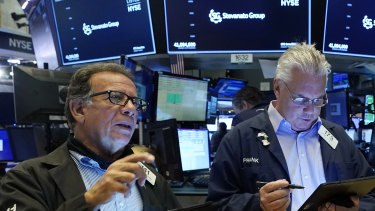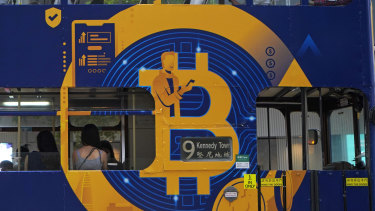
Prices hit records this summer. The UK average jumped to £266,000 ($US500,000) - up £31,000 on the year, according to the Office for National Statistics.
Britain’s boom is but one part of an extraordinarily hot global property market. US prices are up almost 15 per cent, the fastest pace in 30 years. Canada’s market is up almost 14 per cent. New Zealand’s property market is up almost 30 per cent. Australia’s national house prices are 14 per cent higher in 2021.

Sharemarkets are at record highs.Credit:AP
This is all evidence to analysts at the Resolution Foundation that low-interest rates, lockdown savings and shifting demand have been more important factors than Britain’s stamp duty holiday in pushing up prices.
The end of the tax break is unlikely to burst the bubble - but a rise in interest rates could.
Bonds
Families are not the only borrowers who have become extremely used to ultra-low rates.
Governments and businesses have also borrowed hard since the pandemic began with minimal repayments allowing them to spend without too many worries.
Optimism on growth is one thing. Assuming Fed tapering will be smooth and inflation will not become a problem is another.
Low bond interest rates - yields - equal high bond prices, raising concern over the potential for a bust.
Businesses worldwide have borrowed heavily. Non-financial businesses’ debts in advanced economies boomed from 165 per cent of GDP in the final months of 2019 to 185 per cent by the end of 2020, according to the Bank for International Settlements. In emerging markets it jumped from 147 per cent to 173 per cent of GDP. It leaves borrowers vulnerable to a jump in rates.
Loading
Barry Naisbitt, economist at the National Institute of Economic and Social Research, says the extent of the risk depends on how suddenly any rise in rates arrives.
“The average duration of UK government debt is long compared to other countries, so it would not immediately face having to roll over debts [at a higher rate],” he says. “But some countries and companies do need to roll over debts soon and could be caught out by a very sudden change.”
Stocks
America’s S&P 500 rapidly rebounded from the COVID-19 slump and routinely reaches new highs.
Optimism on growth is one thing. Assuming Fed tapering will be smooth and inflation will not become a problem is another.
Mark Haefele, chief investment officer at UBS Wealth Management, expects a “smooth landing” as the Fed eases off the accelerator, but is wary of the hazards ahead.
“Every inflation report above 2 per cent will lead to a chorus of calls for the Fed and other central banks to rein in stimulus, so that inflation doesn’t spiral out of control,” he says.
“At the same time, the Fed knows that overzealous attempts to tame inflation risk putting the economy and markets on course for a hard landing.”
He expects the S&P 500 to rise from almost 4,500 now to 4,800 by June 2022. But with “bad inflation”, a growth crunch or a new COVID-19 scare, the market could tumble to 3,800, erasing almost all of 2021’s gains.
Commodities
The real economy is as big a risk as monetary policy, particularly when it comes to commodity prices.

Cryptocurrencies are soaring, but are notoriously volatile. Credit:AP
Copper offers a salutary lesson to any investors who think everything has to keep rising this year.
The red metal doubled in price between its spring 2020 trough and May 2021, far above pre-pandemic levels as China’s economy boomed and the net zero agenda set demand forecasts soaring. But it stumbled several times as Chinese authorities took action to cool prices, then fears of a new wave of COVID-19 hit demand.
At their low ebb this month prices were down 15 per cent from their peak - high by historical standards, but a sign of how fast a booming market can change.
Bitcoin
If real-world assets are not enough, Bitcoin appears to be on another tear, rising close to $US50,000 in recent days from a July low of below $US30,000. In April, it was more than $US60,000.
Andrew Bailey, Governor of the Bank of England, has been clear about his expectations for the fashionable digital creation. “A cryptoasset is not money (hence the term cryptocurrency is misleading) and has no intrinsic value because it has no backing,” he said earlier this summer.
Loading
Its ultimate value is “highly unstable and could be nothing.”
At least houses can still be lived in when a bubble pops.
Telegraph, London
The Market Recap newsletter is a wrap of the day’s trading. Get it each weekday afternoon.









 Add Category
Add Category